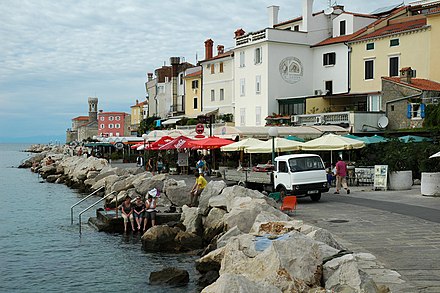Coast and Karst
Coast and Karst
The Coast and Karst region of Slovenia lies along the Adriatic coast and extends inland into the cave-dotted karst territory.
Cities
- Divača — close to the UNESCO World Heritage Site Škocjan Caves
- Dutovlje — picturesque settlement
- Hrastovlje —
- Izola — port
- Lipica — home of the Lipizzaner horses
- Komen — picturesque settlement
- Koper — industrial port city with a Venetian old city
- Nova Gorica
- Piran — port
- Portorož — Beaches, casinos and package tourism
- Postojna — Site of the gigantic Postojna caves
- Sežana
- Štanjel — picturesque clustered settlement
Other destinations
- Inner Carniola (Notranjska) — an area characterised by lakes, caves and wide plains
- Nanos
Understand
Ruled by Venice for five centuries, an Italian influence is clearly visible in the coastal towns of this picturesque area.
Talk
Italian is a second language in many coastal towns and is therefore widely understood.
Get in
By plane
The closest local airport is Portoroz Airport (IATA: POW), near Portorož, which is the smallest of the 3 international airports in Slovenia. It has limited capacity and few international flights, with mostly domestic charter flights during the summer season.
The airport of Trieste in Italy, Trieste – Friuli Venezia Giulia Airport (IATA: TRS) will be a more convenient aerial entry point for travellers coming from outside Slovenia. Trieste has good connections with other European transport hubs such as Heathrow, Frankfurt, Munich, and Charles de Gaulle. There are also international connections outside the European Union.
The largest international airport in Slovenia is Ljubljana Jože Pučnik Airport (IATA: LJU) near the capital Ljubljana, from where the coast can be reached by train on a very scenic route to Koper. Coach services connect all the cities and towns along the coast with Koper.
By bus
KOPER - there are frequent buses between Trieste and Koper (and on to Piran). Journey time is around 1 hour and the distance is about 20 km. There are also frequent buses and trains from Ljubljana (journey time around 2 hours, 90 km). NOVA GORICA - there are frequent buses between Gorizia (Italy) and its Slovenian counterpart (1 euro 3 cents, 10 minutes). Buses and trains head north towards Bled and Jesenice (5 euro, 2 hours). Buses and some trains are also quite frequent between the city and Ljubljana (8 euro, 2.5 hours). SEZANA - on weekdays there are 7 buses a day to/from Trieste (Italy) taking 25 minutes and costing 1 euro. Regular train and bus services run between Sezana and Ljubljana (7 euro, 2 hours)
Get around
See
 Slovenia is rich in caves due to the wide limestone bedrock in the South West, the Coast and Karst that has given name to this particular topography. The Postojna Caves in Postojna is one of the largest cave systems in the world, containing 20 km of underground galleries, chambers and corridors. The Škocjan Caves, near Divača, are on the UNESCO World Heritage List for its natural and cultural significance.
Slovenia is rich in caves due to the wide limestone bedrock in the South West, the Coast and Karst that has given name to this particular topography. The Postojna Caves in Postojna is one of the largest cave systems in the world, containing 20 km of underground galleries, chambers and corridors. The Škocjan Caves, near Divača, are on the UNESCO World Heritage List for its natural and cultural significance.
Do
Eat
Drink
- Tourist farm »Oru«, Davorin Jagodič Avber 2 6210 Sežana, +386 5 768 52 52, +386 41 614 196. Wine tasting, food, wine
Stay safe
With the exception of Koper, Sezana and Nova Gorica all of the settlements are very small and crime is virtually non-existent. In all parts crime is low when compared to all neighbouring countries. Most young people will speak very good English and coastal areas are usually bilingual (Slovene and Italian).
